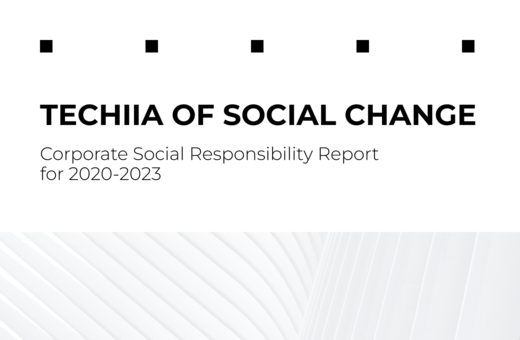
“A state in a smartphone” is one of the main expressions of 2019.
With this promise, the current president’s team came into power. Now they are actively working on this direction in the Cabinet. In addition to the Minister of Digital Transformation Mykhailo Fedorov, the issues of digitization are also handled by the Minister of the Cabinet of Ministers, a well-known fintech entrepreneur Dmytro Dubilet.
At the end of September, a team of government “digital transformers” presented the project — an application and a website, which in the future will “combine ALL services in one electronic window” provided by the state. How did the idea of a “digital state” emerge, and what can we expect from it in the future?
If we consider the digitization of the state using a business approach, the first thing to do is to analyze how much the changes will cost and what practical benefits they will bring soon
The root of the digitization
One of the problems of the current state administration is that, in fact, it uses institutions invented in the 19th century and 20th-century technologies to solve the issues of the 21st century. The mismatch between tasks and tools causes new difficulties. And the apparent outrage: according to the global survey, 85% of citizens around the world think that the system in their country is not working for them. As one of the options to “reboot” the state and restore its service functions, the idea of a “digital state” is evolving.
However, in the early 1990s, this term did not exist in fact. But the corresponding practices were already in the West. Back in the 1960s, the first studies on electronic document management and the use of computers (which were still bulky giants!) in government institutions were being prepared in the USA. In the next decade, the work goes to the system level — in California, a research group URBIS (Urban Information Systems) was gathered. It created one of the first developments of the “digital state.”
However, in the 1970s, Germany and Austria began to engage in similar work actively, later the rest of Europe joined. But the leadership remains with the United States, where in 1986 they started an experiment with filing digital tax returns. If in the beginning, the eFile project processed 25 thousand documents, in 2013, the number of submitted online reports on was more than 122 million.
It should be noted that the concepts of “digital state” and “e-government” should not be mixed up. The former is more general and implies the latter, but not vice versa. E-government should create new ways for citizens and businesses to interact with government agencies. This requires a lot of intellectual capital to analyze current situations and develop new technological solutions.
In Austria, for example, the government created the platform. It coordinates the work of central, regional, and local authorities. The work is divided into four areas:
- information — public access to data from agencies;
- communication — exchange of data with the state;
- transactional — public services and electronic document management;
- personalization — content targeting depending on citizens’ tasks.
In addition to e-government, the digital state includes many features and options. It is worth remembering Estonia, which is called the by The New Yorker. However, even this Baltic country is only in the process of building a digital state.

Innovations may even stop migration. Many leave Ukraine not even for high wages, but for quality of life
The Ukrainian course
Ukraine is not alone in its desire to use the achievements of the IT industry in its government. At the end of 2017, the Deloitte consulting company issued a report on technologies in the international public sector. Then analysts called the idea of symphonic enterprise the main trend in the nearest future. This concept predicts a cumulative effect if both the government and business introduce such technologies as, for example, blockchain and artificial intelligence systems. The purpose of such investments is to increase the efficiency of the entire “digital state” — from the communication of citizens, government agencies, and business to the implementation of tasks on electronic document management.

Yuriy Lazebnikov, managing partner of TECHIIA holding
“If we consider the digitization of the state using a business approach, the first thing to do is to analyze how much the changes will cost and what practical benefits they will bring soon,” says Yuriy Lazebnikov, managing partner of TECHIIA holding. “It is precisely necessary to prioritize such projects and make them with the aim of deliberate use. An example of the introduction of blockchain technologies for land registration showed that only the big word “blockchain” is not enough to make the register transparent and functional.”
The Ukrainian Ministry of Digital Transformation has set itself quite ambitious goals for the next four years: 100% of all public services online, every fifth is automatic (officials do not participate), as well as an online form for a full package of services by the state.
“At first, the total digitization. It is necessary to simplify, deregulate everything that is possible, and convert what will remain into electronic format. This will make all processes more efficient and transparent,” said Cabinet Minister Dmytro Dubilet. He expects that by the end of this year, almost all key processes in the government will be converted into digital format, and next year, this approach will be applied to all ministries.
“Innovations may even stop migration. Many leave Ukraine not even for high wages, but for quality of life. And if thanks to digitization, access to public services become easier, if it is easier to make an appointment to see a doctor — it will be a small, but still an incentive to stay in Ukraine,” says Yuriy Lazebnikov. He underlines that Ukraine competes in the world market for its citizens. “We need to develop very quickly both in terms of technology implementation and economic development as a whole.”

Kira Rudik, former IT entrepreneur and head of Ring Ukraine — a company bought by Amazon
Kira Rudik, former IT entrepreneur and head of the much-talked-about company Ring Ukraine, bought by Amazon, also agrees with him. “In the next 30 years, we will face the question: what is a state in general, if I can work anywhere in the world? What does citizenship mean?” she asks about the evolution of the digital state. “States will compete for citizens with the very set of digital services they provide,” she is sure. Rudik, now a member of parliament, underlines that one of the challenges for authorities in digitization is not to think for a month or a year ahead but at least a decade or two.
Where the future has already come
Let’s return to Estonia, for example — this small Baltic country is more advanced in matters of digitization than anyone else. Every year Estonian citizens use 100-120 e-services, and the government has counted: this is the way to save ten days of life because most public services can be obtained without leaving home.
You need to receive only three services in person (while digital — already more than 2.5 thousand): to register the property, to get married, and to divorce. Each citizen has an identification code which is also the key to obtaining digital public services. And this code also protects the personal data of its owner - institutions can get only the information about the person they need to provide the service. The user can check online who, how, and why requested his or her information, and even complain if he or she finds this unjustified.
The Estonians’ neighbors, the Finns, keep up with them. The internet is so important to them that in 2010, the government legislated for every citizen to have access to broadband internet — Finland was the first in the world to do this. As in Estonia, the ease of online access to public services and automatic translation into other languages attracted foreign experts. And the digital infrastructure itself does not exist in a vacuum — along with it, the country invests in both education and local communities, which means investing in institutions where people can work online.
Ukraine is trying to catch up with the leaders. On October 29, the Cabinet of Ministers signed a memorandum with four major mobile operators — thanks to it, the mobile Internet network the whole territory of the country. And by that time, if the plans of state managers are implemented, a window of communication with the state will also appear in smartphones.
You can read the original article by clicking .


